
ASIA HUNDREDS is a series of interviews and conference presentations by professionals with whom the Japan Foundation Asia Center works through its many cultural projects.
By sharing the words of key figures in the arts and cultures in both English and Japanese and archiving the "present" moments of Asia, we hope to further generate cultural exchange within and among the regions.
Reasons for leaving Tokyo and working in the countryside
Hello, my name is Yukinori Yanagi. I live and work on a remote and isolated Japanese island. To be frank with you, I don't really think that Tokyo is a good place because it is too heavily concentrated. It also means Tokyo exploits many different things from the countryside –workers, nature, and culture. I really do question this situation, so chose to take on the challenge of a project on an island far away from there.
I'm delighted that Tokyo is being invigorated in preparation for the 2020 Olympics and Paralympics. But, if the countryside was also lifted high at the same time, I think that these sporting events would be even greater. Immediately after the 2011 Tōhoku earthquake and tsunami, the Fukushima Daiichi Nuclear Power Plant incident occurred. People in Tokyo depend on electricity sent from the surrounding areas, including Fukushima. It is stated that urban areas are being sustained by the countryside as well as sacrificing the countryside. I'd like you each to keep in mind this master-servant relationship as you listen to my presentation.

The loss of things through the process of modernization and the remains of that process-Encountering Inujima
The Inujima islands lie on the east side of Japan's Seto Inland Sea. The biggest island in this group of islands is called Inujima*1 . It's an extremely small island with a population of around only 40 people. There is no bridge to the island, so it's very inconvenient. I came to know of this island by chance: At the beginning of the 1990s, I was living in New York and the art market had started to become active. It was a period when I started to hold doubts about reality in which it can be said that so-called capital and art were colluding. Transactions of extremely high sums were being conducted on a daily basis. I wanted to begin my life's work in Japan-a life work that followed my Japanese spirit-and after searching for a fitting place and travelling around various places, I chanced upon Inujima.
*1 Inujima is the largest island of the Inujima islands and is located in the Seto Inland Sea. It is the only inhabited, isolated island in Okayama City. And from way back, it has a history of being extremely prosperous due to its copper-smelting industry, quarrying industry, and other such activity, the remains of which still exist today. Since The Inujima Seirensho Art Museum opened in 2008, the island has become known as a contemporary art island.

These are the ruins of a copper smelter*2 dating from the late Meiji era. In its prime, over 2000 workers worked there, and I bet that the environmental pollution was fairly bad. The Meiji era was a period in which Japan frantically imitated the West and pushed forward with its modernization. Japan, Taking a path similar to that taken by the United States and Europe took, Japan also went forth into neighboring Asian countries and colonized those countries. That lust for colonization led to war. I think that while gaining many things, Japan simultaneously lost many things. Things that have been either lost in time or forgotten linger here with the refinery ruins.
*2 The Inujima smelter opened and began operation in 1909. It was active for a while, but, due to the influence of the sharp fall in the price of copper, operations were suspended in 1919, and it was abandoned in 1925.
The incident*3 involving the illegal dumping of industrial waste at Teshima, which is close to Inujima in the Seto Inland Sea, is well known. But, similarly, industrial waste was almost thrown away in the ruins of Inujima. Naturally, that waste is waste from urban areas: waste thrown away by consumers, waste from demolished architectural structures, and other such waste. Things that people want to throw away in urban areas is brought to the countryside. The Seto Inland Sea is splendidly beautiful when viewed from afar. But, when seen from nearby, the reality is that the nature is being exploited and waste is being dumped there. The truth is that the current day's industrial waste might be thrown away in remnants of the Meiji era related to a modernization industry. This, however, carries a highly powerful message: It occurred to me that if that place was combined with art, a marvelous thing would be born. Further, what I'd like to accent is that there is an old shrine where the ruins are, and the traditional lifestyle of people who live with myriad gods still remains.
*3 This is an incident that continued from the mid-1970s for approximately 16 years and had its origin in an illegal and largescale dumping of waste by a private company. In 1990, the Hyogo Prefectural Police exposed the incident, and, in 2000, environmental pollution arbitration was established in Japan. But the problems of removal and contamination are still here now.
I'm interested in a number of elements that are peculiar to Inujima. One of these is that Inujima has been a source of granite called Inujima Stone since the Edo era. It was famous for being a place from which gargantuan stones were quarried. Apparently, the ebb and flow of the tide was used to carry giant stones, and the island is dotted with quarries. The stones were carried as far as Kamakura. Another thing I'm interested in that is peculiar to Inujima is bricks: Heavy slag bricks containing heavy metals that are made in the process of smelting copper.
An old power station's ruins also exist on Inujima. In the past, smoke and soot billowed out from it, and coal was used as fuel to supply energy for the smelting works. Based on the history rooted in the island, the idea came to me to use natural energy, such as sunlight and terrestrial heat, to restore life to the island. This is the genesis of the Inujima Project*4 .
*4 This is an art project that was conceived in 1995 as the Inujima Project (the name of the project at that time) and developed on Inujima. Under the concept of "Use available things to create things that don't exist", Mr. Yanagi cooperated with the architect Hiroshi Sanbuichi on The Inujima Seirensho Art Museum that opened in 2008, which was over 10 years since it had been conceived. The museum also contains a café and a museum shop.

Stone pits dating back to the Edo era are also unique to Inujma. They located across the island that have become deep lakes. I wanted to use all of these types of elements peculiar to the island and turn the entire island into art. There's something that resonates with the thinking of An Min Chi "The town of Georgetown is itself a museum". To illustrate, the beautiful terraced fields, of which there were many on the islands of the Seto Inland Sea, also exist in Vietnam. Those can be viewed as land art. The concept of art is not only things that are displayed in museums. I think, art is integrated with our lives and correlates with human activities.
Inujima Seirensho Art Museum: Integrate art and architecture
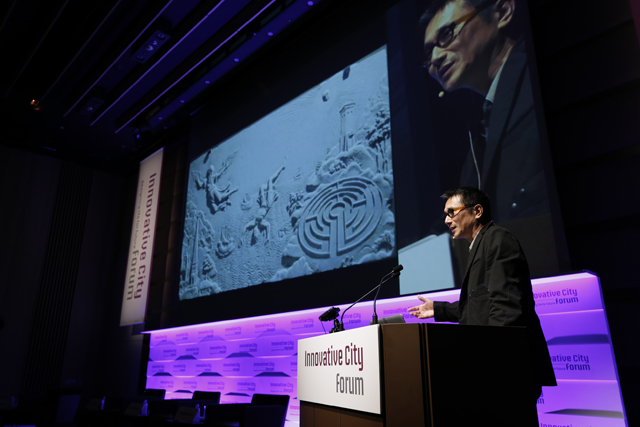
When I saw the abandoned Inujima smelter, the mythology of Icarus came to mind. As many of you will likely know, in this mythology, Icarus, who was imprisoned in an underground labyrinth by King Minos, and Icarus' father, Daedalus, use wings hardened with wax to fly from the tower and escape. Icarus, however, flew too close to the sun, the wax on wings melted, and he fell into the sea. This is very old mythology. But I think that it symbolizes a criticism of modernism, hubris in humans, and overestimating technological capabilities.
I really saw a commonality between this mythology and the Inujima smelter. And I thought that I'd like to create an art-site with Icarus as the motif. Based on this idea, an architect to cooperate with was chosen together with the sponsors. And, in 2008, The Inujima Seirensho Art Museum was completed.

Japan's high economic growth period between the mid-1950s and the 1970s was a period in which architects and fashion designers rapidly branched out overseas, and the government, with great momentum, opened art museums focusing on the construction of the buildings. On the other hand, Japanese artists couldn't really go out into the world. That difference is perhaps due to architecture, in contract to art, having a close connection with the economy. Art is not really compatible with economic activity. The reason why I aimed to be an artist was because I thought that it involves work in which a distinction is made between art's domain and capitalism. I also thought that it is the only work from which a critique mentality can be gained. Japan's art museums and architects use art as decoration for architecture, and I really felt uneasy about that. So I thought that my only option was to make a "vessel" in which to put the that I worshipped.
The Inujima Art Project was initially an artist's idea, my own idea. Next, it went through the process of an art and architecture collaboration. This island is located in the deep countryside of Okayama Prefecture. With a feeling of wanting to create something that is not in Tokyo and of wanting to help local personnel develop by using local technology, together with the people of the Naoshima Fukutake Art Museum Foundation (now merged with the Fukutake Foundation), architects and general contractors who were to conduct construction work were, as much as possible, searched for locally. However, the locals didn't really understand the art, so, to be honest, we had a difficult time.
Finally, we collaborated with an architect in Hiroshima. A design was put together that made use of the Inujima environment and the smelter's functions and characteristics. There is no machine room to control or restrain the air conditioning or humidity level, and only natural energy is used. To illustrate this, the air conditioning is provided by smelter's chimney by using a structure in which a phenomenon known as the chimney effect*5 is used. And the structure is such that in summer, terrestrial heat is used to cool the outer air, and, in winter, an air flow is created through the greenhouse effect of the sun's heat concentrating on the glass rooms of the art museum.
I'd like you to keep in mind the mythology of Icarus, which I mentioned a moment ago. There are many people and motifs appearing in the mythology that are common to the project: the father Daidalos known as a technician and an inventor, the creator of the underground labyrinth, the flight from the tower, the upward air flow, the sun's heat, and the like. People visiting the Inujima Seirensho Art Museum experience the art museum with those metaphors in mind.
*5 Air with a high temperature rises. Due to that, if the inside of the chimney has air of a temperature higher than the outer air, then it rises, and, to make up for that, cold air for outside is dragged in to the chimney via the air intake. The chimney effect means this phenomenon of an air flow occurring within the room due to that.
Reviving the space used by and the ideology of Yukio Mishima–Group of artworks in the Inujima Seirensho Art Museum
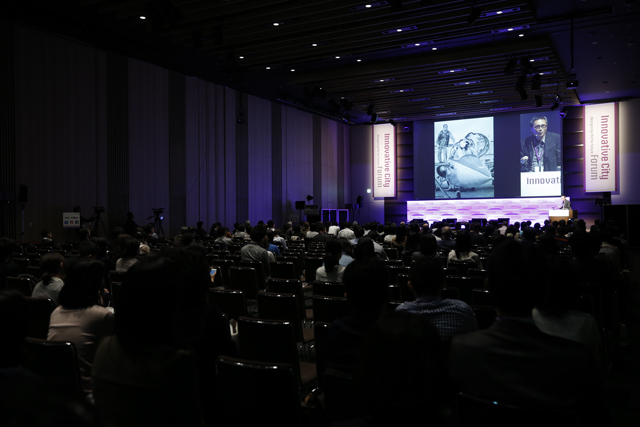
In this manner I've spoken about, the artworks that were unified with the architecture of the Inujima Seirensho Art Museum were also created through taking inspiration from the Icarus mythology. Another element inspired by the Icarus myth is that of Yukio Mishima, a novelist and political activist. On March, 14 1967, Mishima boarded and sat in the rear seat of a Self-Defense Force fighter aircraft F104DJ, and improvised the long poem Icarus*6 . My idea was to bring Yukio Mishima into the heart of the museum's architecture and artwork. The artist Mishima, who criticized postwar Japan for its disregarding of culture and pursuance only of economic growth and ultimately went as far as giving a "performance" *7 in which he committed suicide. I wanted to explore ways to merge the following three elements: The Inujima smelter, which had turned to ruins after being left behind in the process of modernization; the Icarus mythology; and Yukio Mishima.
*6 This was featured in Yukio Mishima's Sun and Steel, an autobiographical essay and critique (Kodansha; 1968).
*7 This is known as the Mishima Incident. On 25 November 1970, Yukio Mishima, to plead for a constitutional amendment, attempted to inspire the Self-Defense Force to start a coup d'état at the Ground Self-Defense Force garrison in Ichigaya. He committed ritual suicide immediately after that.
At that time, I happened to hear that a house that Mishima had lived in was being demolished, and I came up with the idea of cutting it up and turning it into an artwork. This artwork that is a reincarnation of the house that stood in Shoto in Shibuya City, Tokyo, in a remote place in the countryside, Inujima, is called Solar Rock.
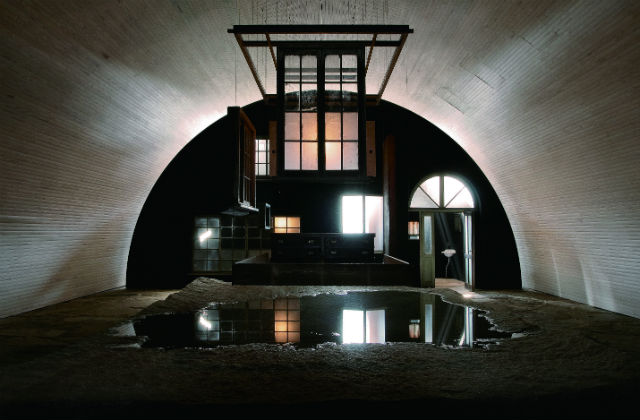
Actually, only the fittings of the house remain. And as we couldn't relocate and reconstruct the house, we dismantled it and used it for art materials. For this artwork, approximately 50 tons of stone were brought in. The only place that large stones can be used for art is this island as it's a place in which stones are quarried. We put this artwork in an art museum and water was placed in the space. In the upper area, fittings from Mishima's small three-tatami-sized study were reconstructed by hanging them from the ceiling. And a black sun is reflected in the water basin.
Inside Icarus Tower, which is another artwork displayed in the art museum, you can see a urinal placed on the ground. This urinal is also from Mishima's house, and he actually used it. Those with some knowledge of art history will realize that this is a homage to Marcel Duchamp's urinal*8 .
*8 Marcel Duchamp's Fountain (1917) was displayed as an artwork in which a slight addition has been made to an already existing product. Also, existing products in the original were used (i.e., a readymade).This work courted controversy. He is recognized as a pioneer of conceptual art.

Incidentally, each room of this art museum is a reconstruction of each room in Mishima's house while also functioning architecturally. In the artwork Mirror Note, a 6-tatami-sized room of Mishima's house has been reconstructed, but it is also acts as a windbreak room that blocks air from the outside and inside of the building.
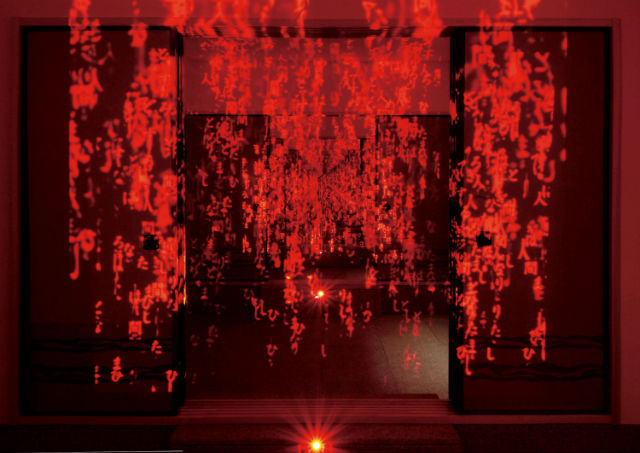
This room's mirror has reflected in it a video of text from Mishima's short story called Eirei no Koe (Voices of the Heroic Dead) *9 . The words are the curse in Eirei no Koe: "Nadote Sumerogi wa hito to naritamaishi.(などてすめろぎは人間となりたまいし)(English translation: Why would His Majesty become an ordinary man?). Mishima wrote these words from the perspective of a dead person. In other words, soldiers and the bereaved could, as the emperor was a god, come to terms with death by seeing meaning in it. But, if the emperor becomes human, then those people that died in war will have died for no purpose. This phrase, which is repeated in Eirei no Koe, speaks of the anger felt at the loyalty given to the emperor being betrayed from the perspective of the young officers of the February 26 Incident and the pilots.
*9 This appeared in Bungei (June 1966 edition). On 30 June 1966, it was published in book form by Kawade Shobo Shinsha.
In addition, in the artwork Solar Note, which is based on Yukio Mishima's 8-tatami-sized room, the manifesto that Mishima read aloud on the balcony of the Ground Self-Defense Force garrison in Ichigaya immediately before committing suicide is hanging from the ceiling in the form of gold-plated cutout letters. This text contains Mishima's anger towards the state of affairs in post-war Japan. A travel bag that Mishima used is placed in the middle, and the overall structure is based on the concept of Pandora's box, the artifact in Greek mythology.

Aside from the four artworks I've introduced so far, there is also an artwork that makes one think of Icarus' labyrinth (Icarus' Cell) and an artwork made with smelter slag (Slag Note). All six of these are collectively called Hero Battery. Each of these artworks makes use of scrap wood from Mishima's house in Shoto and makes use of the Inujima environment. The name Hero Battery was taken as is from the product name of the battery used in the doorbell at the entrance of Mishima's house. It can also be interpreted as a doorbell for making a connection with the deceased and with history.

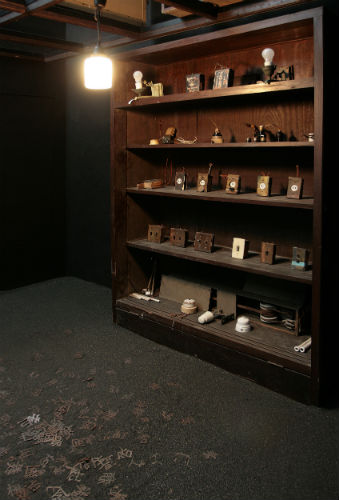
The resuscitative ability of art-Finding new possibilities in abandonment
I'd like to introduce to you a project that took place on another island. Kansai International Airport, which opened in 1994, is an example of the countryside being exploiting by an urban area. This airport is on a completely artificial island, and to make the land reclaimable, mountains on nearby islands were cut away and, in some cases, the islandtotally disappeared. After learning of this, I pushed forward a project called the Kosagijima Bio Isle Project. This project looks at an island as a single life form. While surveying matters on site, I am reviving a vacant house, creating a gallery, and engaging in other activities.
On an island called Momoshima, I'm engaged in a project called Art Base Momoshima*10 . We renovated an abandoned school, and turned it into an art museum. Here, even the toilets are used as an exhibition space. Artwork here uses waste oil and exhaust gas, which cannot be used in exhibits in an ordinary museum because of the odors they emit. We also renovated an abandoned movie theatre in a project called the Former Momoshima Toei Revival Project*11 . After the renovation, the people on the island were gathered and a 16mm version of "Mothra vs. Godzilla" was screened, because it was the last film to be screened here. In the future, my next move would be to exhibit artworks using the entire island as the site.
*10 This is a project in which a school building of the former Momoshima Junior High School, which closed in 1999, was re-used as an art centre. In 2010, the closed-down school building was renovated together with people who cooperated, and, over approximately two years, an art space was created. The art space opened under the name of Art Base Momoshima on 4 November 2012. The artworks on display at Art Base Momoshima change occasionally, and a special exhibition is held every autumn.
*11 A screening event took place on 13 August 2014. The original movie theatre, Momoshima Toei, opened in 1964, and it closed around the 1970s.
I'd also like to introduce to you a project taking place in Onomichi. Many of the boats travelling to islands in the Seto Inland Sea set off from Onomichi in Hiroshima Prefecture. Due to this, there are many warehouses in the middle of Onomichi and in the bay. But as they do not satisfy the new earthquake-proof regulations, they cannot be used, and are just sat there. To me, this is a big waste. To be honest, in a regular white-cube gallery, my imagination doesn't become active. But in a place such as these warehouses, anything can be done, so my imagination goes wild. There are also expansive spaces, and you can make holes and bang nails in. These are things that are often impossible to do in a Japanese art museum.
In 2014, an exhibition called Crossroad*12 was held in one of these warehouses. Akin to the other warehouses, it was prohibited for an undefined large number of people to occupy the warehouse, because the earthquake proofing was insufficient. Due to this, with the concept of peeking at Japan's shame, we decided to hold an exhibition in which everyone didn't go inside and peeked at the inside from the outside.
*12 Crossroad was on view from Saturday, September 13, 2014 to Sunday, October 26 2014 in Nishigosho Prefectural Warehouse No. 3 and in the former Momoshima Toei movie theatre. The participating artists were Miyako Ishiuchi, Noriyuki Haraguchi, Yukinori Yanagi, and Bruce Conner.
In Yukinori Yanagi × Noriyuki Haraguchi, large-scale installations were shown in the same warehouse in 2012. Noriyuki Haraguchi's*13 artwork was called "F-8E CRUSADER" and was made with a tailfin of a fighter aircraft used in the Korean War and the Vietnam War. And my artwork was called "Atomic Article 9" and consisted of Article 9 of the Japanese Constitution written in neon. Each of these was of a scale and of a subject that is not possible to display in a regular art museum in Japan.
*13 Noriyuki Haraguchi started to work as an artist in 1966 and is well-known as a representative artist of Mono-ha and Post-mono-ha. His artwork Oil Pool has drawn global attention. It's an artwork that was shown in Documenta 6 (Kassel, Germany) in 1977 in which an iron pool is filled with waste oil. Since then, he has created artworks that intervene in the atmosphere of a place by pursuing the beauty and texture of materials themselves and not playing about with materials while simultaneously not treating the sense of presence that materials possess as perfect.
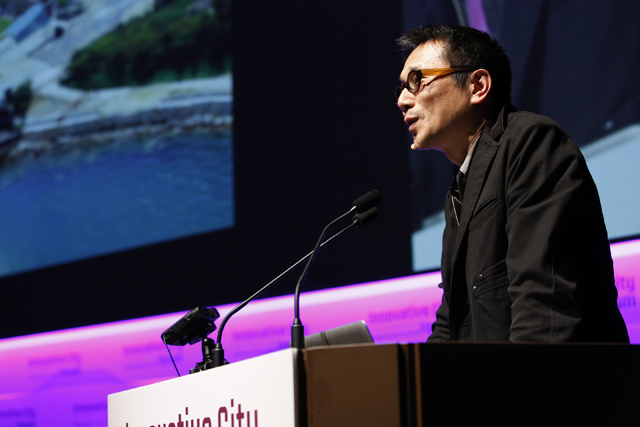
Currently (this lecture was held in October 2016). I have a solo exhibition*14 at Bank ART in Yokohama. This art center is also a refurbished warehouse. In this exhibition, I recreated the Icarus' labyrinth originally shown in Inujima. In Inujima, there were things that couldn't be realized because of architectural limitations. But, at Bank ART, I could freely go beyond those kinds of limitation. This labyrinth-like artwork actual has a zig-zag path, but by placing mirrors at each corner, it looks straight. I expressed my image of Icarus flying off by having light come in from a skylight and having that light fall at the end of the path.Yukio Mishima's poem Icarus is carved in glass that is installed in a corner.
*14 Yukinori Yanagi; Wandering Position (Bank ART Studio NYK; Friday October 14 to Saturday January 7 2017 -)
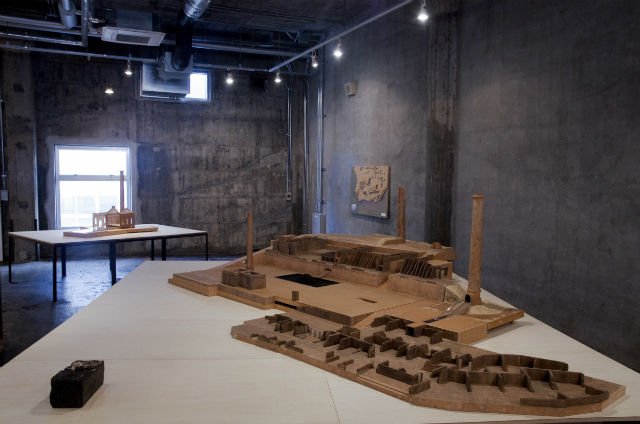
(BankART studio NYK, 2016)
(C)YANAGI STUDIO
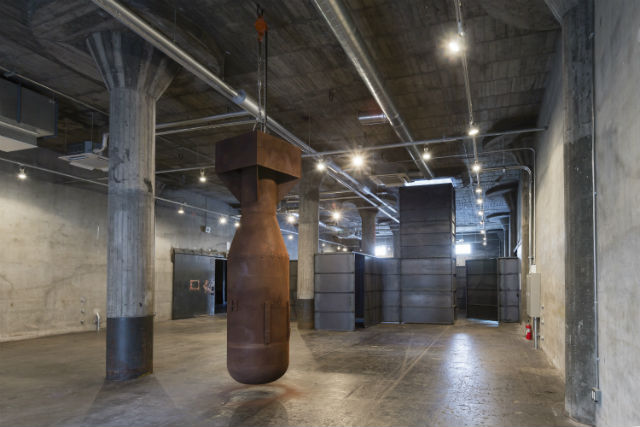
Display scenary
(BankART studio NYK, 2016)
(C)YANAGI STUDIO
An artwork conceptualizing Godzilla involved a scrap wood mountain with big eyes Godzilla appears from the Pacific Ocean and became gargantuan because of a hydrogen bomb experiment by America. But it can also be said to be the souls of the dead of the Pacific War. In other words, this also touches on sacrifices made by human hubris due to trusting science too much in recent times and that hubris causes sacrifice.
Art is the goal; it isn't a means
As I've spoken about, I've been involved in art that sheds light on the history and characteristics of the local land. The reason why I pursue art in this kind of environment rather than Tokyo is because I want to be free. What I mean by this is that I want to choose the environment in which I create art. Recently, as you likely know, public subsidies are being provided to regional areas thanks to regional revitalization. And art is being used to revitalize local towns. Something I've been saying recently to friends is that art is the goal, it's not a means. If an artist loses his or her goal, then the art will gradually be used as a means. It is true that sponsors and patrons are needed. But they change the form of art and the form of culture. I think it's important that artists are conscious of that influence and create edgy things while cleverly using that influence and maintaining a sense of critique. As for me, I don't want to be involved with mainstream art museums and art. And my mind is always occupied with chewing over how to make art and environments that indicate an anti-urban stance.

More Information
Editor: Satoko Shibahara






